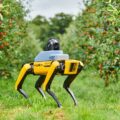At Robotic.blog, we are dedicated to exploring and showcasing the latest advancements in robotics technology. Our mission is to provide insightful information, expert analyses, and innovative solutions that push the boundaries of what robotics can achieve. Join us as we delve into the exciting world of robotics and discover how it is transforming industries and shaping the future.
What is Robotics?
Robotics is an area of interdisciplinary research in science and engineering that designs, constructs, and uses robots. It merges areas like mechanical engineering, electrical engineering, computer science, among others, to come up with a machine capable of helping or substituting human actions. As technology continues to advance, robotics marches forward in innovation, which also brings about disruptive developments across a wide range of domains.
What is a Robot?
A robot is a reprogrammable automatically controlled machine that can perform a number of complex actions. Robots may be autonomous, semi-autonomous, or teleoperated and serve to carry out any task without concern for dangerousness, repetition, or anything beyond human capacity. Modern robots are endowed with advanced sensors, processors, and actuators to interact with the environment and perform intricate tasks with high precision.
Aspects of Robotics These may include the following
- Mechanical Design: This is the making of the actual body and structure of the robot in such a way that it will be robust and effective.
- Electronics: The development of circuits and systems that drive and control the robot, such as microcontrollers and embedded systems.
- Software: Writing software code for the robot to execute the operations and act on environment inputs by using software languages like Python, C++, and ROS (Robot Operating System).
- Artificial Intelligence: Machine learning and AI for the realization of ability in robots to make decisions, learn from experiences, and be flexible toward new situations, thus improving their autonomy and functionality.
- Human-Robot Interaction (HRI): A research and design of ways in which robotic devices can enable humans to communicate with and work safely and efficiently with them, thus allowing a smooth and safe interaction between the two of them.
What Are the Key Parts of a Robot?
Major components of a robot
- Sensors: These sense the environment —cameras, LIDAR, ultrasonic sensors, and tactile sensors.
- Actuators: They cause movement through the conversion of energy—for example, motors, servos, and hydraulic systems.
- Control Systems: These perform data processing and issue commands for robot activity; often, they are associated with real-time computing and feedback loops.
- Power Supply: The energy is usually provided by batteries, solar panels, or wired power sources to move the robotic device.
- End Effectors: At the end of a robotic arm, tools or devices are often used, including grippers, cameras, or special instruments for such tasks as welding or surgery.
What Industries Are Using Robotics?
Robotics have made a breakthrough in many fields, including
- Manufacturing: Automation of the production lines improves precision and efficiency and lowers people’s labor cost. Robots perform welding, painting, assembly, and material-handling work.
- Healthcare: Assisting in surgeries, rehabilitation, patient care, and hospital logistics. Surgical robots enable minimally invasive procedures, and rehabilitation robots aid in physical therapy.
- Agriculture: Makes crop monitoring and planting more efficient. The use of robots that are equipped with sensors and AI could identify individual plants within a field and tend to them, thus increasing yields while saving on resources.
- Logistics: Warehousing operations, picking efficiencies, and delivery systems have been modernized. Robotics technology enables a revolution in inventory management and last-mile delivery through autonomous mobile robots and drones.
- Automotive: From making vehicles autonomous to enhancing assembly lines. Robotics technology is key in developing self-driving cars and advanced manufacturing processes.
- Construction: Safer and more efficient building processes. Robots can do such dangerous work as demolition, bricklaying, and even the 3D printing of structures.
- Entertainment: More immersive films, gaming, and theme parks due to the use of animatronics and interactive robots in order to enhance the story and hook the audience.
Healthcare Leading the Robotics Innovation
Space Healthcare is an area within which robotics is making giant strides. These have facilitated solutions bringing about an improvement in patient outcomes, enhancement of surgical precision, and general efficiency in hospital operations. Some highlight applications include:
- Surgical Robots: Enable highly precised minimally invasive surgery, reducing recovery times and improving patient outcomes. Systems like the Da Vinci Surgical System allow surgeons to perform complex procedures through small incisions.
- Rehabilitation Robots: These robots help patients return to their functional form in terms of mobility and strength following an injury or surgery. They give personalized, consistent therapy to help patients recover more effectively.
- Telemedicine Robots: These facilitate telemedical consultations and examinations and are really useful in rural or underserved areas, enhancing access to care and allowing for distance-located specialists to deliver this care.
- Hospital Robots: Perform functions, including medicine dispensation, sanitation, and logistics, so that hospital staff can keep their focus on the patient. They contribute to hygiene and efficient operation within hospitals.
The Future of Robotics
The future of robotics is incredibly promising with advancements in artificial intelligence, machine learning, and materials science driving innovation. In healthcare, robots are set to revolutionize patient care, diagnostics, and surgical procedures. Robots will improve medical outcomes and positively affect lives through applications such as telemedicine robots, robotic prosthetics, and AI-assisted surgeries. These flexible robots will pervade our very normal life and perform our cleaning up to complex industrial operations. For soft robotics, biohybrid robots, and cobots, both new ways of interaction and new functionalities will be designed. As ethical and regulatory landscapes continue to evolve, responsible development and deployment of robotics will ensure they positively contribute to society. Find out with us in this all-embracing guide how the world is being reshaped by the existence of robotics, and the mind-blowing potential that lies ahead for this dynamic field. Our guide offers you some invaluable insights regarding the very fast-changing world of robotics.
